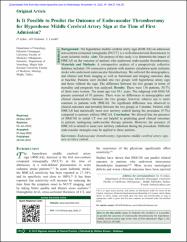Is it possible to predict the outcome of endovascular thrombectomy for hyperdense middle cerebral artery sign at the time of first admission?
Citation
Aykac O, Ozdemir AO, Cenikli U. Is it possible to predict the outcome of endovascular thrombectomy for hyperdense middle cerebral artery sign at the time of first admission? Niger J Clin Pract. 2022 Oct;25(10):1674-1680. doi: 10.4103/njcp.njcp_2050_21. PMID: 36308238.Abstract
Background: The hyperdense middle cerebral artery sign (HMCAS) on admission non-contrast computed tomography (NCCT) is a well-characterized phenomenon in acute ischemic stroke. Aim: The purpose of this study is to determine the impact of HMCAS on the outcome of patients who underwent endovascular thrombectomy. Materials and Methods: A retrospective analysis of a prospectively collective database included 136 consecutive patients with anterior circulation acute ischemic stroke who underwent endovascular thrombectomy. We collected the demographics, and clinical and brain imaging as well as functional and imaging outcomes data at baseline. Patients were divided into two groups with hyperdense artery sign and those without the sign. The difference between the two groups in terms of mortality and prognosis was analyzed. Results: There were 136 patients, 50.7% of them were women. The mean age was 59.1 years. The subgroup with HMCAS present consisted of 93 patients. There were no differences in demographics and clinical characteristics between the two groups; however, tobacco use is more common in patients with HMCAS. No significant difference was observed in clinical outcomes and mortality between the two groups at 3 months. Patients with HMCAS had statistically more new territory emboli during the procedure (9.7%) compared to patients without HMCAS. Conclusion: We showed that the presence of HMCAS in initial CT was not helpful in predicting good clinical outcomes in patients undergoing endovascular therapy patients. However, the presence of HMCAS is related to more new territory embolism during the procedure. Different endovascular strategies may be applied to these patients.


















